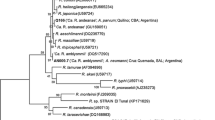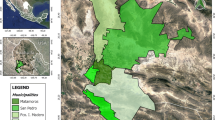Abstract
In this study, we identified two Haemaphysalis species present at the Khao Yai National Park in Thailand and investigated the presence of rickettsia in these ticks. A total of 166 Haemaphysalis specimens were collected randomly under leaves along visitor paths at five locations in the park. Male and female adults of two different Haemaphysalis species, H. shimoga and H. lagrangei, were identified. Polymerase chain reaction (PCR) analysis revealed Rickettsia bacteria in these two Haemaphysalis species; this study represents the first time such presence has been reported in Thailand. The infection rates of Rickettsia were in both H. shimoga (7.41%) and H. lagrangei (10.17%) at these locations in addition to two pools of Haemahysalis nymphs (28.57%). Furthermore, 25.93% of H. shimoga showed positive results that matched Haemaphysalis longicornis symbionts (92% sequence identity) and the Coxeilla burnetti 16S ribosomal RNA gene (90% sequence identity). We propose that this is a novel H. shimoga symbiont bacterium in Thailand and might be a novel Coxeilla-like agent or Coxeilla sp. found in H. shimoga. In contrast, we did not observe any Wolbachia bacteria, which also belong to the order Rickettsiales, in the same group of Haemaphysalis ticks. Furthermore, PCR was used to detect three other genera of bacteria, Anaplasma, Ehrlichia and Borrelia, none of which were identified in the Haemaphysalis ticks studied.

Similar content being viewed by others
References
Anderson BE, Sumner JW, Dawson JE et al (1992) Detection of the etiologic agent of human ehrlichiosis by polymerase chain reaction. J Clin Microbiol 30:775–780
Ariyakulwong P, Wiwatwitaya D (2006) Relationships between mammal abundance diversity and distribution of hard tick (Acari: Ixodidae) in Khao Yai National Park. Thai J For 25:44–57
Azad AF, Beard CB (1998) Rickettsial pathogens and their arthropod vectors (Review). Emerg Infect Dis 2:179–186
Barker SC, Murrell A (2008) Systematic and evolution of ticks with a list of valid genus and species names. In: Bowman AS, Nuttall PA (eds) Ticks: biology, disease and control. Cambridge University Press, Cambridge, pp 1–39
Bernasconi MV, Casati S, Peter O et al (2002) Rhipicephalus ticks infected with Rickettsia and Coxiella in Southern Switzerland (Canton Ticino). Infect Genet Evol 2:111–120
Burgdorfer W (1988) Ecological and epidemiological consideration of Rocky Mountain spotted fever and scrub typhus. In: Walker DH (ed) Biology of rickettsial diseases. CRC Press, Boca Raton, pp 33–50
Choi YJ, Lee SH, Park KH et al (2005) Evaluation of PCR-based assay for diagnosis of spotted fever group rickettsiosis in human serum samples. Clin Diagn Lab Immunol 12:759–763
Hoogstraal H (1970) Current studies on tick biology in relation to diseases in Eurasia, Africa, Madagascar, and Australia, vol 6. Miscellaneous Publication of Entomological Society of America, College Park, pp 359–363
Hoogstraal H (1981) Changing patterns of tick borne diseases in modern society. Annu Rev Entomol 26:75–99
Hirunkanokpun S, Kittayapong P, Cornet JP et al (2003) Molecular evidence for novel tick-associated spotted fever group rickettsiae from Thailand. J Med Entomol 40:230–237
Holden PR, Brookfield JF, Jones P (1993) Cloning and characterization of an ftsZ homolog from a bacterial symbiont of Drosophila melanogaster. Mol Gen Genet 240:213–220
Krause PJ, McKay K, Thomson CD et al (2002) Disease-specific diagnosis of coinfecting tick-borne zoonoses: babesiosis, human granulocytic ehrlichiosis, and Lyme disease. Clin Infec Dis 34:1184–1191
La Scola B, Raoult D (1997) Laboratory diagnosis of rickettsioses: current approaches to diagnosis of old and new rickettsial diseases. J Clin Microbiol 35:2715–2727
Lee JH, Park HS, Jung KD et al (2003) Identification of the spotted fever group rickettsiae detected from Haemaphysalis longicornis in Korea. Microbiol Immunol 47:301–314
Lee JH, Park HS, Jang WJ et al (2004) Identification of the Coxiella sp. detected from Haemaphysalis longicornis ticks in Korea. Microbiol Immun 48:125–130
McDade JE, Newhouse VF (1986) Natural history of Rickettsia rickettsii (review). Annu Rev Microbiol 40:287–309
Mediannikov OV, Ivanovl L, Nishikawa M et al (2003) Molecular evidence of Coxiella-like microorganism harbored by Haemaphysalis concinnae in the Russian Far East. Ann NY Acad Sci 990:226–228
Noda H, Munderloh UG, Kurtti TJ (1997) Endosymbionts of ticks and their relationship to Wolbachia spp. and tick-borne pathogens of human and animals. Appl Environ Microbiol 63:3926–3932
Pancholi P, Kolbert CP, Mitchell PD et al (1995) Ixodes dammini as a potential vector of human granulocytic ehrlichiosis. J Infect Dis 172:1007–10012
Parola P, Raoult D (2001) Tick and tick-borne bacterial disease in humans: an emerging infectious threat. Clin Infect Dis 32:897–928
Raoult D, Roux V (1997) Rickettsioses as paradigms of new or emerging infectious diseases (review). Clin Microbiol Rev 4:694–719
Roshdy MA (1968) A rickettsialike (sic) microorganism in the tick Ornithodoros savignyi; observations on its structure and distribution in the tissues of the tick. J Invert Path 11:155–169
Simon C, Franke A, Martin A (1991) The polymerase chain reaction: DNA extraction and amplification. In: Hewiett GH, Johnston AB, Young JW (eds) Molecular technique in taxonomy. Springer, Berlin, pp 329–355
Sun J, Liu Q, Lu L (2008) Coinfection with four genera of bacteria (Borrelia, Bartonella, Anaplasma, and Ehrlichia) in Haemaphysalis longicornis and Ixodes sinensis ticks from China. Vector Borne Zoonotic Dis 8:791–795
Swofford DL (1999) PAUP: Phylogenetic analysis using parsimony, version 4.0 betal. Centre for Agriculture and Bioscience International, Champaign
Tanskul P, Inlao I (1989) Keys to the adult ticks of Haemaphysalis Koch, 1844, in Thailand with notes on changes in taxonomy (Acari: Ixodoidea: Ixodidae). J Med Entomol 26:573–601
Werren JH (1997) Biology of Wolbachia. Annu Rev Entomol 42:587–609
Weisburg WG, Barns SM, Pelletier DA et al (1991) 16S ribosomal DNA amplification for phylogenetic study. J Bacteriol 173:697–703
Williams SG, Sacci JB, Schriefer ME et al (1992) Typhus and typhus-likerickettsia associated with opossums and their fleas in Los Angeles County, California. J Clin Microbiol 38:3498–3501
Acknowledgments
This work was supported by the Biodiversity Research and Training Program (BRT T252060), the Faculty of Science, Mahidol University, Thailand research grant (SCY52-03), and the Thailand Research Fund and Office of the commission on Higher Education.
Author information
Authors and Affiliations
Corresponding author
Rights and permissions
About this article
Cite this article
Ahantarig, A., Malaisri, P., Hirunkanokpun, S. et al. Detection of Rickettsia and a Novel Haemaphysalis shimoga Symbiont Bacterium in Ticks in Thailand. Curr Microbiol 62, 1496–1502 (2011). https://doi.org/10.1007/s00284-011-9887-3
Received:
Accepted:
Published:
Issue Date:
DOI: https://doi.org/10.1007/s00284-011-9887-3




